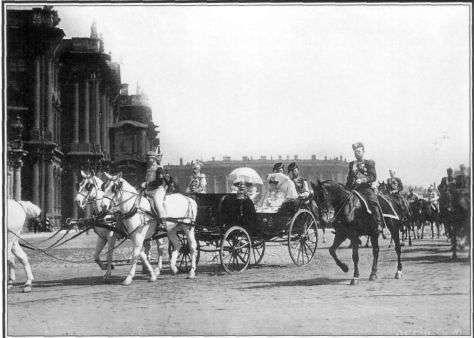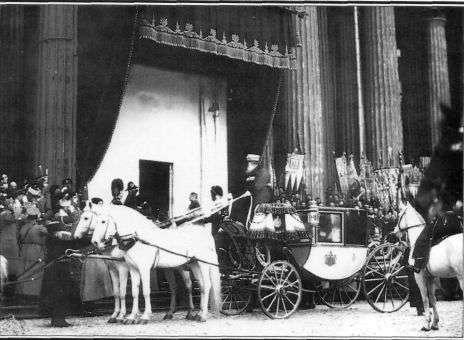A People's Tragedy (22 page)
Read A People's Tragedy Online
Authors: Orlando Figes


2 The imperial family rides from the Winter Palace to the Kazan Cathedral for the opening ceremony of the tercentenary.
3 Nicholas II rides in public view for the first time since the 1905 Revolution.


4 The famous Yeliseev store on Nevsky Prospekt is decorated for the tercentenary.
5 Guards officers greeting the imperial family at the Kazan Cathedral. Note the icons, the religious banners, and the crosses of the onlookers.


6 Townspeople and peasants come to see the Tsar in Kostroma during the tercentenary provincial tour.
7 The court ball of 1903 was a landmark in the cult of ancient Muscovy. Each guest dressed in the seventeenth-century costume of his twentieth-century rank. The Tsar and Tsarina are standing in the centre of the front row.

8 The Temple of Christ's Resurrection on the Catherine Canal - a hideous example of the last tsars' efforts to 'Muscovitize' St Petersburg.


9 Trubetskoi's bronze statue of Alexander III on Znamenskaia Square in St Petersburg.
The workers called it 'the hippopotamus'.
10 The Moscow statue of Alexander III - with its back to the Cathedral of Christ the Saviour - at its opening ceremony in 1913.


11 The imperial family
(right to left):
Olga, Tatyana, Nicholas, Alexandra, Maria, Alexis and Anastasia.
12 Rasputin with his admirers. Anna Vyrubova, the closest friend of both Rasputin and the Empress, is standing fifth from left.

13 The Tsarevich Alexis with his playmate and protector, the sailor Derevenko. After the February Revolution Derevenko joined the Bolsheviks.
contained a fairly comprehensive set of moral concepts. True, these were not always applied uniformly. The peasant-class courts often functioned in a random manner, deciding cases on the basis of the litigants' reputations and connections, or on the basis of which side was prepared to bribe the elected judges with the most vodka. Yet, amidst all this chaos, there could be discerned some pragmatic concepts of justice, arising from
the
peasants' daily lives, which had crystallized into more-or-less universal legal norms, albeit with minor regional variations.
Three legal ideas, in particular, shaped the peasant revolutionary mind. The first was the concept of family ownership. The assets of the peasant household (the livestock, the tools, the crops, the buildings and their contents, but not the land beneath them) were regarded as the common property of the family.* Every member of the household was deemed to have an equal right to use these assets, including those not yet born. The patriarch of the household, the
bol'shak,
it is true, had an authoritarian influence over the running of the farm and the disposal of its assets. But customary law made it clear that he was expected to act with the consent of the other adult members of the family and that, on his death, he could not bequeath any part of the household property, which was to remain in the common ownership of the family under a new
bol'shak
(usually the eldest son). If the
bol'shak
mismanaged the family farm, or was too often drunk and violent, the commune could replace him under customary law with another household member. The only way the family property could be divided was through the partition of an extended household into smaller units, according to the methods set out by local customary law. In all regions of Russia this stipulated that the property was to be divided on an equal basis between all the adult males, with provision being made for the elderly and unmarried women.21 The principles of family ownership and egalitarian partition were deeply ingrained in Russian peasant culture. This helps to explain the failure of the Stolypin land reforms (1906—17), which, as part of their programme to create a stratum of well-to-do capitalist farmers, attempted to convert the family property of the peasant household into the private property of the
bol'shak,
thus enabling him to bequeath it to one or more of his sons.f The peasant revolution of 1917
